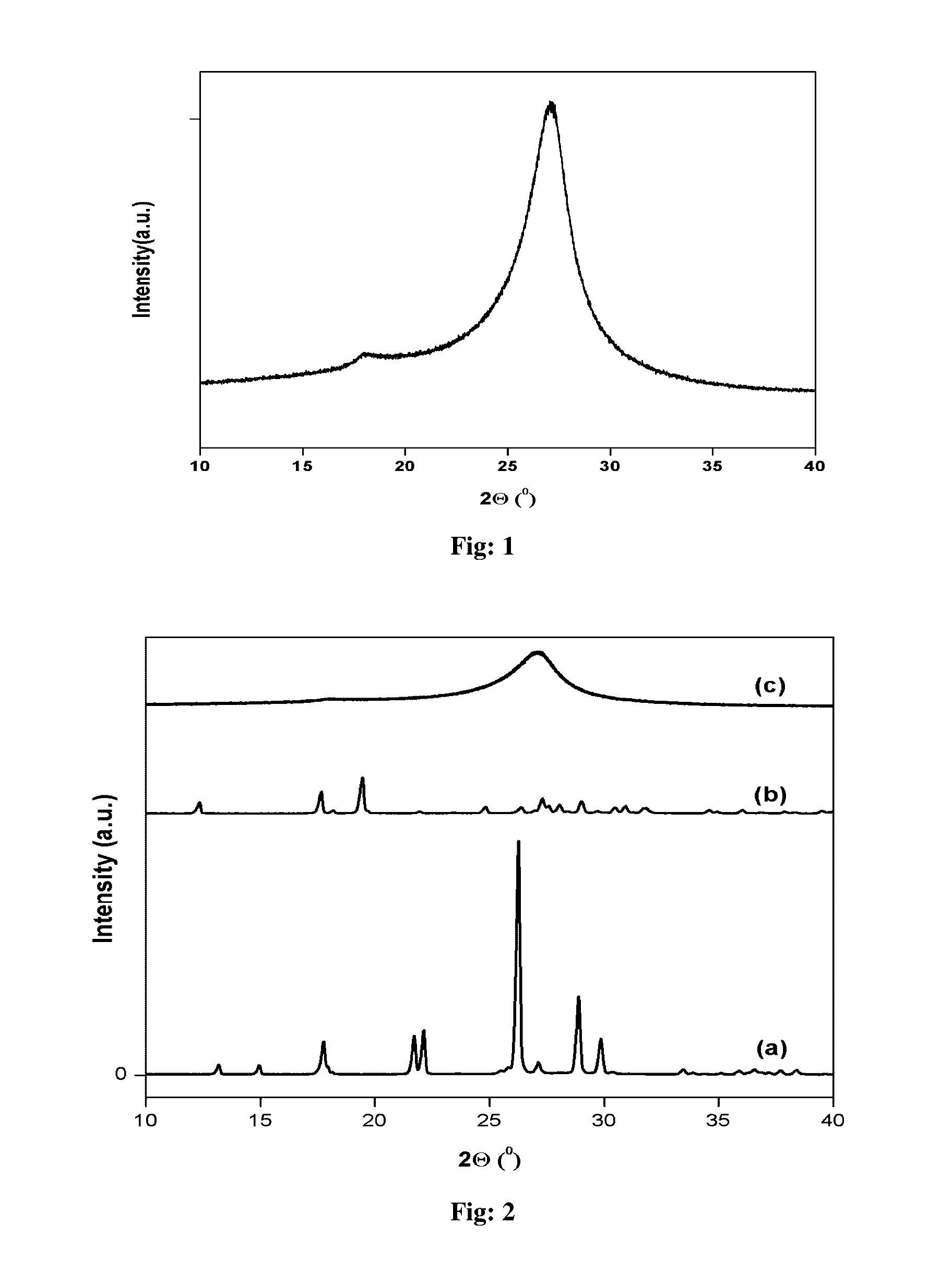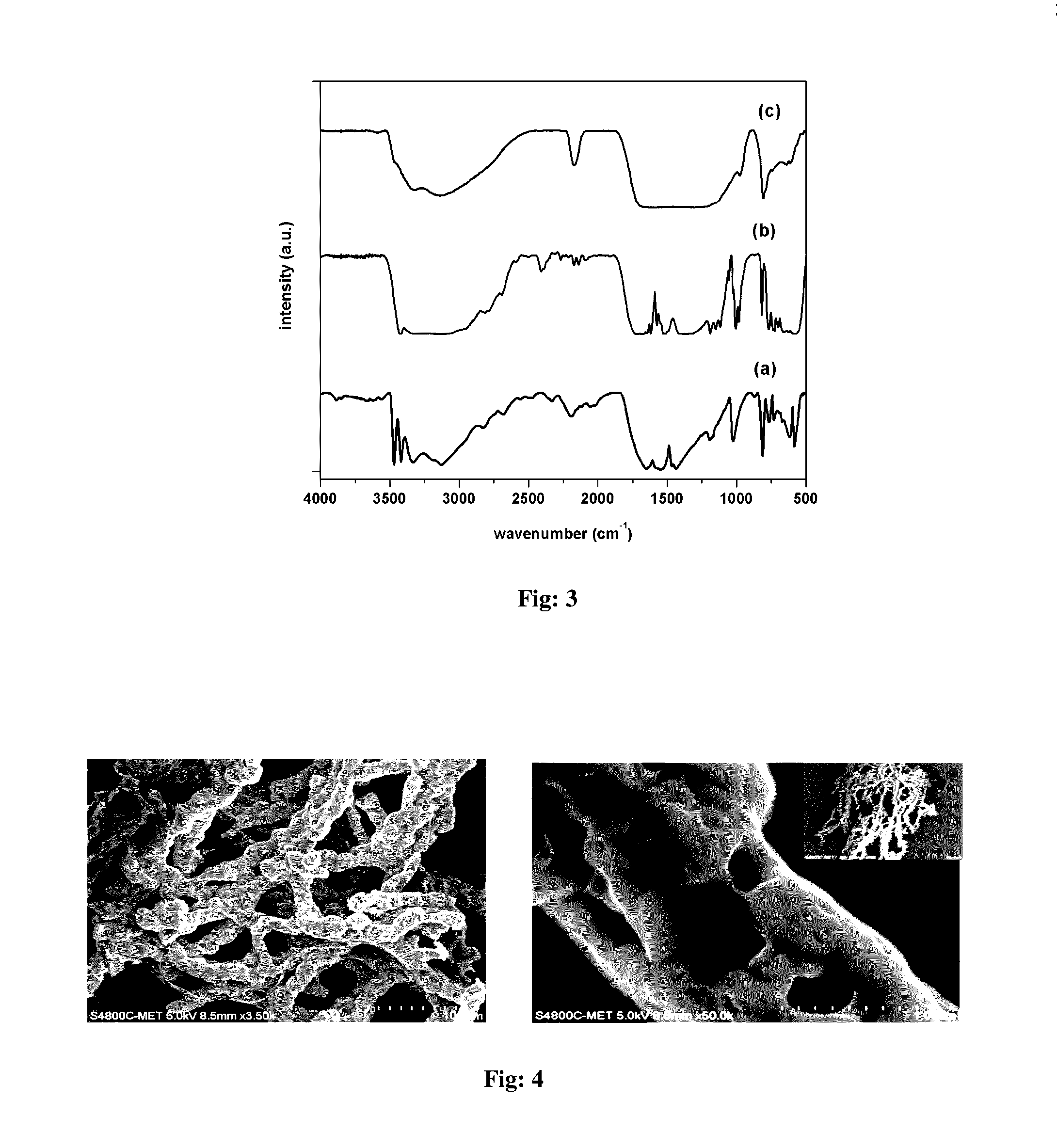Selective aerobic oxidations using carbon nitride nanotubes
- Summary
- Abstract
- Description
- Claims
- Application Information
AI Technical Summary
Benefits of technology
Problems solved by technology
Method used
Image
Examples
example 1
Preparation of Catalyst
[0060]Melamine (0.9068g) was dissolved in ethylene glycol (40 ml) to obtain a saturated solution at 30° C. temperature. To this, aqueous nitric acid (120 ml of 0.12 M) was added drop wise to get white precipitate. This was washed by ethanol to remove residual nitric acid and ethylene glycol. Subsequently, the product was dried at 60° C. for 6 h and calcined at 350° C. for 3 h in air.
Characterization of Catalyst
XRD
[0061]The structural aspects of the catalysts were investigated by powder X-ray diffraction. FIG. 1 shows two peaks. The most intense peak at around 27.2° corresponds to interlayer distance d=0.336 nm, close to the characteristic peak of the (002) plane in the g-C3N4 structure (d=0.336 nm) which is reported for graphite-like carbon nitride (d=0.321, or 0.328 nm). The peak characteristic to in-plane structural packing motif of the nanotube appears at 17.8° (d=0.49 nm), close to the theoretical d=0.47 nm. So it is evident from XRD that the present nanot...
example 2
[0070]Synthesis of Adipic Acid from Cyclohexane
[0071]Initially 12.6 of cyclohexane, 6.1 g of acetonitrile and 50 mg of catalyst was placed in 50 mL parr autoclave. The mixture was heated to desired temperature, reactor was pressurized with oxygen. After the completion of reaction products are identified by HPLC and GC:
[0072]Selective oxidation of cyclohexane (CH) to adipic acid was carried out using carbon nitride nano tube catalysts. Optimization of various experimental parameters was carried out to optimize the adipic acid yields.
[0073]Effect of Temperature: The effect of temperature on selective oxidation of cyclohexane is shown in FIG. 13. It is seen that CH conversion as well as AA selectivity increased initially with temperature, but AA yield drops after reaching a maximum. On the other hand, CH conversion increased continuously with temperature with about 24% at 125° C. to 86 mol % at 140° C. Cyclohexanol and cyclohexanone were also found in the product, particularly at low r...
example 3
Synthesis of Adipic Acid from Cyclohexanone
[0084]Initially 9 g of cyclohexanone, 7 g of acetonitrile, 2 g of water and 50 mg of catalyst was placed in 50 mL parr autoclave. The mixture was heated to desired temperature, reactor was pressurized with oxygen. After the completion of reaction products are identified by HPLC:
[0085]Effect of temperature: Effect of the reaction temperature on catalytic activity in the selective oxidation of cyclohexanone to AA is shown in FIG. 21. Increasing the reaction temperature promotes conversion of cyclohexanone. Selectivity of AA reaches maximum at 120° C., but decreases beyond this temperature. The decrease in AA selectivity is attributed to the decarboxylation at higher temperatures to form C2, C4 dicarboxylic acids.
[0086]Effect of reaction time on catalytic activity: Effect of reaction time on catalytic activity of CNT in the selective oxidation of cyclohexanone is given in FIG. 22. Conversion of cyclohexanone has increased with increasing time ...
PUM
| Property | Measurement | Unit |
|---|---|---|
| Temperature | aaaaa | aaaaa |
| Mass | aaaaa | aaaaa |
| Substance count | aaaaa | aaaaa |
Abstract
Description
Claims
Application Information
 Login to View More
Login to View More - R&D
- Intellectual Property
- Life Sciences
- Materials
- Tech Scout
- Unparalleled Data Quality
- Higher Quality Content
- 60% Fewer Hallucinations
Browse by: Latest US Patents, China's latest patents, Technical Efficacy Thesaurus, Application Domain, Technology Topic, Popular Technical Reports.
© 2025 PatSnap. All rights reserved.Legal|Privacy policy|Modern Slavery Act Transparency Statement|Sitemap|About US| Contact US: help@patsnap.com



